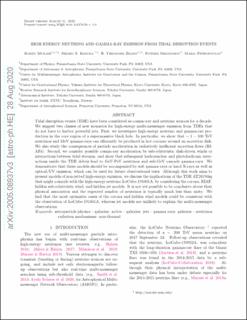| dc.description.abstract | Tidal disruption events (TDE) have been considered as cosmic-ray and neutrino sources for a decade. We suggest two classes of new scenarios for high-energy multi-messenger emission from TDEs that do not have to harbor powerful jets. First, we investigate high-energy neutrino and gamma-ray production in the core region of a supermassive black hole. In particular, we show that ∼1–100 TeV neutrinos and MeV gamma rays can efficiently be produced in hot coronae around an accretion disk. We also study the consequences of particle acceleration in radiatively inefficient accretion flows (RIAFs). Second, we consider possible cosmic-ray acceleration by sub-relativistic disk-driven winds or interactions between tidal streams, and show that subsequent hadronuclear and photohadronic interactions inside the TDE debris lead to GeV-PeV neutrinos and sub-GeV cascade gamma rays. We demonstrate that these models should be accompanied by soft gamma rays or hard X-rays as well as optical/UV emission, which can be used for future observational tests. Although this work aims to present models of non-jetted high-energy emission, we discuss the implications of the TDE AT2019dsg that might coincide with the high-energy neutrino IceCube-191001A, by considering the corona, RIAF, hidden sub-relativistic wind, and hidden jet models. It is not yet possible to be conclusive about their physical association and the expected number of neutrinos is typically much less than unity. We find that the most optimistic cases of the corona and hidden wind models could be consistent with the observation of IceCube-191001A, whereas jet models are unlikely to explain the multi-messenger observations. | en_US |
